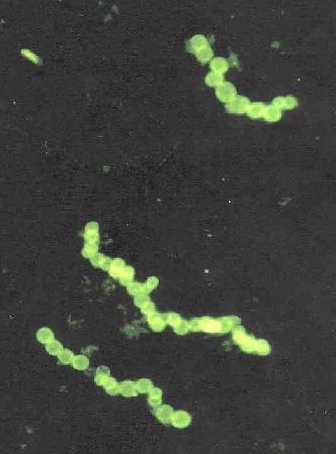Thiomargarita namibiensis food storage: Difference between revisions
| Line 1: | Line 1: | ||
==Introduction== | ==Introduction== | ||
The Thiomargarita namibiensis was discovered in 1997 by Heidi N. Schulz off of the coast of Walvis Bay, Namibia, Africa. The Thiomargarita namibiensis is a sulfide eating bacteria and although it mainly consumes sulfides, the Thiomargarita namibiensis also consumes some amounts of nitrates. The Thiomargarita namibiensis is currently the largest found bacteria (up to 0.3 mm in diameter). A separate strand of the Thiomargarita namibiensis was also found of the coast of the Gulf of Mexico in 2005 but this strand does not does not divide along a single axis and because of that, it is unable to form large chains. | |||
The | |||
<br><br> | <br><br> | ||
[[Image:Sulphide_bacteria_crop.jpg|thumb|500px|right|Electron micrograph of the Ebola Zaire virus. This was the first photo ever taken of the virus, on 10/13/1976. By Dr. F.A. Murphy, now at U.C. Davis, then at the [https://phil.cdc.gov/details_linked.aspx?pid=10815 CDC].]] | [[Image:Sulphide_bacteria_crop.jpg|thumb|500px|right|Electron micrograph of the Ebola Zaire virus. This was the first photo ever taken of the virus, on 10/13/1976. By Dr. F.A. Murphy, now at U.C. Davis, then at the [https://phil.cdc.gov/details_linked.aspx?pid=10815 CDC].]] | ||
| Line 16: | Line 11: | ||
<br><b>Pixel size:</b> |300px| | <br><b>Pixel size:</b> |300px| | ||
<br><b>Placement on page:</b> |right| | <br><b>Placement on page:</b> |right| | ||
<br><b>Legend/credit:</b> | <br><b>Legend/credit:</b> Stained micrograph of the Thiomargarita namibiensis bacteria in 2007. Taken by NASA. | ||
<br><b>Closed double brackets:</b> ]] | <br><b>Closed double brackets:</b> ]] | ||
<br><br>Other examples: | <br><br>Other examples: | ||
Revision as of 17:26, 5 December 2020
Introduction
The Thiomargarita namibiensis was discovered in 1997 by Heidi N. Schulz off of the coast of Walvis Bay, Namibia, Africa. The Thiomargarita namibiensis is a sulfide eating bacteria and although it mainly consumes sulfides, the Thiomargarita namibiensis also consumes some amounts of nitrates. The Thiomargarita namibiensis is currently the largest found bacteria (up to 0.3 mm in diameter). A separate strand of the Thiomargarita namibiensis was also found of the coast of the Gulf of Mexico in 2005 but this strand does not does not divide along a single axis and because of that, it is unable to form large chains.

At right is a sample image insertion. It works for any image uploaded anywhere to MicrobeWiki. The insertion code consists of:
Double brackets: [[
Filename: PHIL_1181_lores.jpg
Thumbnail status: |thumb|
Pixel size: |300px|
Placement on page: |right|
Legend/credit: Stained micrograph of the Thiomargarita namibiensis bacteria in 2007. Taken by NASA.
Closed double brackets: ]]
Other examples:
Bold
Italic
Subscript: H2O
Superscript: Fe3+
Section 1 Genetics
Include some current research, with at least one image.
Sample citations: [1]
[2]
A citation code consists of a hyperlinked reference within "ref" begin and end codes.
Section 2 Microbiome
Include some current research, with a second image.
Conclusion
Overall text length should be at least 1,000 words (before counting references), with at least 2 images. Include at least 5 references under Reference section.
References
Edited by [Author Name], student of Joan Slonczewski for BIOL 116 Information in Living Systems, 2020, Kenyon College.
